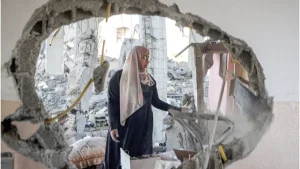Saudi Arabia and China: A Perfect Match
The ambitious “Saudi Vision 2030” is moving forward vigorously, including the following key goals: development of photovoltaic and other new energy projects, construction of the amazing futuristic city Neom, and reducing dependence on oil while increasing the proportion of non-oil sectors. Strong infrastructure capabilities are the foundation for achieving these goals. However, rich Saudi oilmen are obviously not good at sweating themselves out to build infrastructures, and the kingdom is not known for majestic urban clusters or skyscrapers either.
Middle Eastern countries have long lacked building materials, equipment, skilled workers, and engineering capabilities. As the world’s leader in infrastructure construction, these are exactly what China is best at. In addition, the cooperation between China and the Arab world is now in a honeymoon period. China’s strong infrastructure capacity has begun to be continuously imported into Saudi Arabia.
Currently, China’s real estate market is in a downturn cycle. Many real estate companies have frequently collapsed. Real estate investment has cooled. Related industries such as cement, steel, coatings, and residential decoration have experienced an oversupply due to weakened demand. The huge idle infrastructure capacity needs to be digested, and the Arab world with money and demand, has become an important destination for capacity export.
Mohammed bin Salman (MBS), Saudi Crown Prince is ambitious. He plans to lead the kingdom to improve its global economic ranking from 19th to 15th by 2030. He also plans to launch a number of grand projects to attract worldwide attention in the fields of housing, urban construction, ports, logistics, high-speed rail, cultural tourism, etc.
 Crown Prince Mohammed bin Salman on the Great Wall during his official trip to China in 2019. | Source: Arab News
Crown Prince Mohammed bin Salman on the Great Wall during his official trip to China in 2019. | Source: Arab News
According to Knight Frank’s forecast, Saudi Arabia’s total construction output value is expected to reach $181.5 billion by 2028, an increase of nearly 30% compared to 2023. By then, it will become the world’s largest infrastructure market. Even now, it can be called one of the world’s largest infrastructure markets.
Shouldering the historic task of transformation and waving huge amounts of money, the opportunities brought about by Saudi Arabia’s infrastructure boom are very likely to help Chinese construction companies reach another peak.
Saudi Arabia’s Historic Turning Point
The Middle East, rich because of oil, is also trapped due to oil.
March 1, 1938, was a milestone in Saudi Arabia’s history. On that day, an exploration team discovered enough oil in the desert to be commercially exploitable, and the country’s destiny began to turn. In 1948, the world’s largest onshore oil field, Ghawar Oil Field, was discovered with proven reserves twice the total of all Chinese oil fields. In 1951, the world’s largest offshore oil field, Safaniya Oil Field, was discovered. In just a few decades, Saudi Arabia became the world’s largest oil exporter.
In the 1960s and 1970s, taking advantage of the Middle East wars, Saudi Arabia led OPEC to raise oil prices, and its economy started to boom. Relying on huge oil revenues, the kingdom created an economic miracle and established its status as a world-class rich country in one fell swoop.
 World Oil Reserves by Country | Source: WorldAtlas
World Oil Reserves by Country | Source: WorldAtlas
However, as a major energy commodity, oil prices fluctuate drastically. Oil revenue once accounted for 85% of Saudi Arabia’s fiscal revenue. Over-reliance on oil caused the kingdom to have eight consecutive years of fiscal deficits and negative economic growth during the last round of the oil price downturn. The government’s financial pressure is still considerable. Other Middle Eastern oil-producing countries share the same sentiment.
Change is imperative. In 2016, Saudi Arabia launched the “Vision 2030” and “National Transformation Program”, trying to promote economic diversification through reform, activate the private sector, increase non-oil industry income, accelerate the development of new energy, and ultimately achieve sustainable economic development. Especially after MBS was designated as the Crown Prince in 2017, under his leadership, the kingdom’s historic reform began.
Infrastructure and real estate are important units in Saudi Arabia’s economic reform. The “Vision 2030” plans to spend 4.13 trillion riyals (about $1.1 trillion) on these two units. Its goal is to achieve a 70% self-sufficiency rate in residential housing by 2030. At present, the Real Estate Development Fund has injected about $12 billion US into the Sakani Housing Program.
Riyadh has also unveiled real estate projects worth a total of $104 billion, with plans to build more than 555,000 dwellings, more than 275,000 hotel rooms, more than 4.3 million square meters of retail space, and more than 6.1 million square meters of office space.
Among all the projects, the most anticipated one is the Neom project. The core of the Neom project is the Line, with a length of 170 kilometers, a width of 200 meters, and a capacity of 9 million people. The Crown Prince plans to spend nearly $500 billion on it (currently undergoing certain scale and budget cuts), hoping that it can become an iconic and eternal architectural wonder like the Egyptian pyramids.
 Rendering of the Line | Source: Neom.com
Rendering of the Line | Source: Neom.com
The Line will use clean energy such as wind and solar power to achieve 100% zero carbon emissions. Under the framework of Neom, several megaprojects will also be built, such as the tropical ice and snow kingdom Trojena, the floating port and trade hub Oxagon, etc. International airports and supporting green ecological, medical, gymnastic, leisure, cultural, and recreational facilities have all started.
Faisal Durrani, head of Middle East research at Knight Frank, said: “Vision 2030 has ignited the passion of the entire Kingdom of Saudi Arabia, and as Neom becomes the crown jewel of the National Transformation Program, people are eager to become part of history.”
Ambitious Middle Eastern tycoons have no shortage of capital, but it is basically impossible to finish such megaprojects without the participation of the “Infrastructure Maniac”. By far, with only about 6 years left, the construction of the projects has generally not been as fast as expected. Under great pressure, the cooperation between Saudi Arabia and Chinese companies will be closer.
Chinese Enterprises to Enter Saudi Arabia
Three months ago, NEOM CEO Nadhmi Al-Nasr led a delegation to China for a seven-day visit to Beijing, Shanghai, Hong Kong, and Shenzhen. The main purpose of this visit was to promote NEOM and seek potential partners. “NEOM is a complex and huge project. Such a project requires the participation of a large number of Chinese companies to achieve, and will bring huge opportunities to them,” said Nadhmi during the visit.
 NEOM delegation promoted the project in Shanghai. | Source: NEOM.com
NEOM delegation promoted the project in Shanghai. | Source: NEOM.com
In fact, since the release of Vision 2030, Chinese construction companies have shown their prowess in Saudi Arabia. For example, China State Construction participated in the pilot project of the Line – the Saudi Transportation Tunnel Project, which includes two parallel high-speed rail tunnels and heavy freight tunnels, with a single line length of 15.75 kilometers and a contract value of approximately $2.47 billion.
On July 12, China State Construction announced that it had successfully won the bid for the King Salman Neighborhood worth $2.08 billion. This is the second Saudi megaproject undertaken by it.
Signing ceremony for the cooperation between China State Construction and El Seif Engineering Contracting Company to build King Salman Neighborhood | Source: China State Construction
Other Chinese companies have also participated in other Saudi construction projects. In May this year, the pilot branch tunnel project of the Line in which China Railway Construction participated was officially completed. This is the first completed project undertaken by a Chinese company under the framework of NEOM.
In May, Saudi Housing Minister Majid Al-Hogail also visited China and reached a cooperation agreement with SINOMACH to build 20,000 residential units, and later reached an agreement with CITIC Construction Group to build a building materials logistics and industrial center. This center will consist of 12 factories. After completion, it will greatly enhance the kingdom’s self-sufficiency in building materials, in order to solve the project delays and cost problems caused by building materials supply shortages.
To promote economic diversification and get rid of dependence on traditional fossil energy, new energy is a top priority of Saudi Arabia. As early as 2014, SEPCO, a subsidiary of POWERCHINA, cooperated with Saudi Aramco to undertake the Jazan IGCC Complex (contract value of approximately $2 billion), which is China’s first high-end Saudi project, breaking the monopoly of European and American companies in the Middle East construction market.
To date, SEPCO and Saudi Arabia have cooperated seven times. The cumulative contract value of the two sides has exceeded US$10 billion, involving multiple EPC projects such as wind, solar, and energy storage.

Chinese and Saudi engineers were discussing at a tunnel construction site. | Source: China State Construction
In addition, state-owned enterprises such as Sinopec, China National Petroleum Corporation (CNPC), China Metallurgical Group Corporation (MCC Group), China National Chemical Engineering Group Corporation (CNCEC), China Communications Construction Company (CCCC) , State Grid Corporation of China (SGCC) and Energy China have also begun to play an important role in infrastructure projects in the Middle East.
Led by these state-owned enterprises, the upstream and downstream companies of China’s construction and engineering industry chain are collectively taking root in the Middle East and achieving common prosperity. For example, in the early days of SEPCO’s cooperation with Saudi Arabia, the Saudis highly praised European and American manufacturing and were skeptical of Chinese manufacturing. However, SEPCO finally persuaded them with its leading technology to include a series of Chinese companies in its supplier list. According to incomplete statistics, SEPCP has promoted the export of a total of $650 million worth of Chinese equipment and materials since it cooperated with Saudi Aramco.
Complementary Interests Between China and Saudi Arabia
The economies of China and Middle Eastern countries are highly complementary, which is the foundation for cooperation between the two sides.
China is the world’s largest industrial producer and oil importer, and the Middle East’s huge oil reserves just meet China’s energy demands. China’s steel, cement, photovoltaic, wind power, and other production capacities are all the greatest in the world, and in the context of insufficient domestic demand in China, they need to be sold to overseas markets.
Therefore, the transaction between the two sides is mutually beneficial. In 2022, imports from Saudi Arabia accounted for 18% of China’s total crude oil imports, making it China’s largest oil supplier. On the other hand, the kingdom imports machinery, electronic products, and other goods from China.
Since 2001, Saudi Arabia has been China’s largest trading partner in the Middle East, and since 2013, China has become its largest trading partner. By 2022, China was not only its largest export market but also its largest import market.
In 2023, mainland China’s crude steel production reached 1.019 billion tons, accounting for 53.9% of the global total, with consumption at 50.8%, both ranking first in the world. In 2023, global cement production was 4.072 billion tons, with that of China accounting for nearly half. Since 1985, China has maintained its position as the world’s largest cement producer for 38 consecutive years.
 China has remained the largest crude steel producer for five consecutive years. | Source: World Steel Association
China has remained the largest crude steel producer for five consecutive years. | Source: World Steel Association
However, with the transformation of China’s economic structure, real estate investment has entered a downward cycle, leading to a deep adjustment in the construction industry. In 2023, due to the decline in demand, sectors such as steel, cement, waterproof materials, and concrete are all being forced to transform.
Oriental Yuhong, a leading enterprise in waterproof materials, has established an “overseas priority” strategy. China National Materials Group Corporation (CNBM), the world’s largest cement technology equipment engineering integration company, has long begun expanding overseas. Its project for Union Cement Company in the UAE is the first overseas cement production line built by a Chinese company with a daily production capacity of 10,000 tons. In 2023, CNBM signed new overseas contracts worth nearly $4.6 billion, a significant increase of 55% year-on-year, far surpassing its domestic contracts.
 Among the top 10 largest cement producers, 6 of them are Chinese companies. | Source: World Cement Association
Among the top 10 largest cement producers, 6 of them are Chinese companies. | Source: World Cement Association
Due to the impact of international relations, the export performance of Chinese building materials varies across different regions. Exports of steel to the European Union and the United States have significantly declined, while exports to Africa, Latin America, and other Asian countries have been increasing. Notably, in 2023, China’s steel exports to the Middle East and North Africa reached 18.095 million tons, a substantial year-on-year increase of 60.4%.
The diverse economic endowments of different regions lay the foundation for cooperation, making the Belt and Road Initiative highly compatible with Saudi Vision 2030. The Middle East, as a critical juncture connecting Asia, Africa, and Europe, holds an indispensable strategic position in the Belt and Road Initiative. Meanwhile, China’s strong, efficient, and leading manufacturing and infrastructure capabilities, along with its advanced innovation capacity, can empower Middle Eastern countries to achieve economic diversification and reduce their reliance on the energy sector.
Conclusion
It is evident that both China and Saudi Arabia are undergoing profound economic transformations. Although directions of transition differ, their economic complementarities will ultimately bring them together, enabling them to achieve grand strategic visions.




